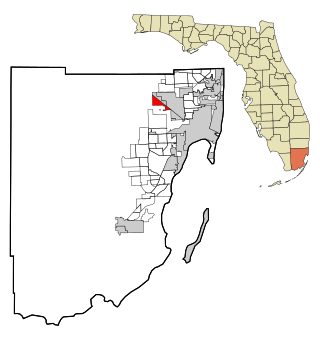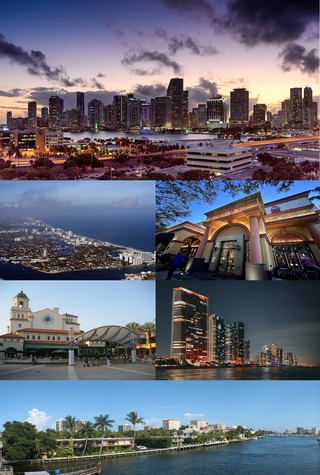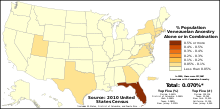
Doral is a city in Miami-Dade County, Florida, United States. One of 34 municipalities in the county, it is located 5 miles (8 km) west of Miami International Airport and 13 miles (21 km) west of Downtown Miami. Doral occupies 15 square miles (39 km2) bordered on the west by the Ronald Reagan Turnpike and the Florida Everglades, on the north by the town of Medley, on the east by the Palmetto Expressway and on the south by the Dolphin Expressway and the city of Sweetwater. The city is part of the Miami metropolitan area of South Florida. As of the 2020 census, Doral had a population of 75,874, up from 45,704 in 2010.

Medley is a town in Miami-Dade County, Florida, United States. The town is part of the Miami metropolitan area of South Florida. As of the 2020 US census, the population was at 1,056 residents.

Westchester is a census-designated place (CDP) and neighborhood in Miami-Dade County, Florida. It is part of the Miami metropolitan area of South Florida. Prior to the 2020 U.S. Census, the neighboring University Park CDP was merged into Westchester CDP, effectively doubling its geography and population. Per the 2020 census, the population was 56,384.

The Miami metropolitan area, also known as South Florida, SoFlo, SoFla, the Gold Coast, the Tri-County Area, or Greater Miami, and officially the Miami–Fort Lauderdale–West Palm Beach Metropolitan Statistical Area, is a coastal metropolitan area in southeastern Florida. It is the ninth-largest metropolitan statistical area (MSA) in the United States, the fifth-largest metropolitan area in the Southern United States, and the largest metropolitan area in Florida. With a population of 6.18 million, its population exceeds 31 of the nation's 50 states as of 2023. It comprises the three most populated counties in the state, Miami-Dade County, Broward County, and Palm Beach County, which rank as the first, second, and third-most populous counties in the state, respectively. Miami-Dade County, with 2,701,767 people in 2020, is the seventh-most populous county in the United States.

Cuban Americans are Americans who immigrated from or are descended from immigrants from Cuba, regardless of racial or ethnic origin. As of 2022, Cuban Americans were the fourth largest Hispanic and Latino American group in the United States after Mexican Americans, Stateside Puerto Ricans and Salvadoran Americans.

Haitian Americans are a group of Americans of full or partial Haitian origin or descent. The largest proportion of Haitians in the United States live in Little Haiti to the South Florida area. In addition, they have settled in major Northeast cities such as New York City, Boston, Philadelphia, Baltimore and Washington, D.C., and in Chicago and Detroit in the Midwest. Most are immigrants or their descendants from the mid-late 20th-century migrations to the United States. Haitian Americans represent the largest group within the Haitian diaspora.

Colombian Americans, are Americans who have Colombian ancestry. The word may refer to someone born in the United States of full or partial Colombian descent or to someone who has immigrated to the United States from Colombia. Colombian Americans are the largest South Americans Hispanic group in the United States.
Honduran Americans are Americans of full or partial Honduran descent. Hondurans are the eighth largest Hispanic group in the United States and the third largest Central American population, after Salvadorans and Guatemalans. Hondurans are concentrated in Texas, Florida and California, and are now the largest immigrant group in Louisiana.

Stateside Puerto Ricans, also ambiguously known as Puerto Rican Americans, or Puerto Ricans in the United States, are Puerto Ricans who are in the United States proper of the 50 states and the District of Columbia who were born in or trace any family ancestry to the unincorporated US territory of Puerto Rico.
Chilean Americans are Americans who have full or partial origin from Chile.

Jamaican Americans are an ethnic group of Caribbean Americans who have full or partial Jamaican ancestry. The largest proportions of Jamaican Americans live in South Florida and New York City, both of which have been home to large Jamaican communities since the 1950s and the 1960s. There are also communities of Jamaican Americans residing in Connecticut, Georgia, New Jersey, Pennsylvania, Maryland, Massachusetts, and California.
Argentine Americans are Americans whose full or partial origin hails from Argentina.

A Nicaraguan American is an American of Nicaraguan descent. They are also referred to as "nica" or "nicoya".

Ecuadorian Americans are Americans of full or partial Ecuadorian ancestry. Ecuadorian Americans are the 9th largest Latin American group in the United States. Ecuadorian Americans are usually of Mestizo, Amerindian or Afro-Ecuadorian background.
Guatemalan Americans are Americans of full or partial Guatemalan descent. The Guatemalan American population at the 2010 Census was 1,044,209. Guatemalans are the sixth largest Hispanic group in the United States and the second largest Central American population after Salvadorans. Half of the Guatemalan population is situated in two parts of the country, the Northeast and Southern California.
Costa Rican Americans are Americans of at least partial Costa Rican descent.
Panamanian Americans are Americans of Panamanian descent.

Paraguayan Americans are Americans of Paraguayan descent.
Uruguayan Americans are Americans of Uruguayan ancestry or birth. The American Community Survey of 2006 estimated the Uruguayan American population to number 50,538, a figure that notably increased a decade later.

The Venezuelan refugee crisis, the largest recorded refugee crisis in the Americas, refers to the emigration of millions of Venezuelans from their native country during the presidencies of Hugo Chávez and Nicolás Maduro since the Bolivarian Revolution. The revolution was an attempt by Chávez and later Maduro to establish a cultural and political hegemony, which culminated in the crisis in Venezuela. The resulting refugee crisis has been compared to those faced by Cuban exiles, Syrian refugees and those affected by the European migrant crisis. The Bolivarian government has denied any migratory crisis, stating that the United Nations and others are attempting to justify foreign intervention within Venezuela.

















